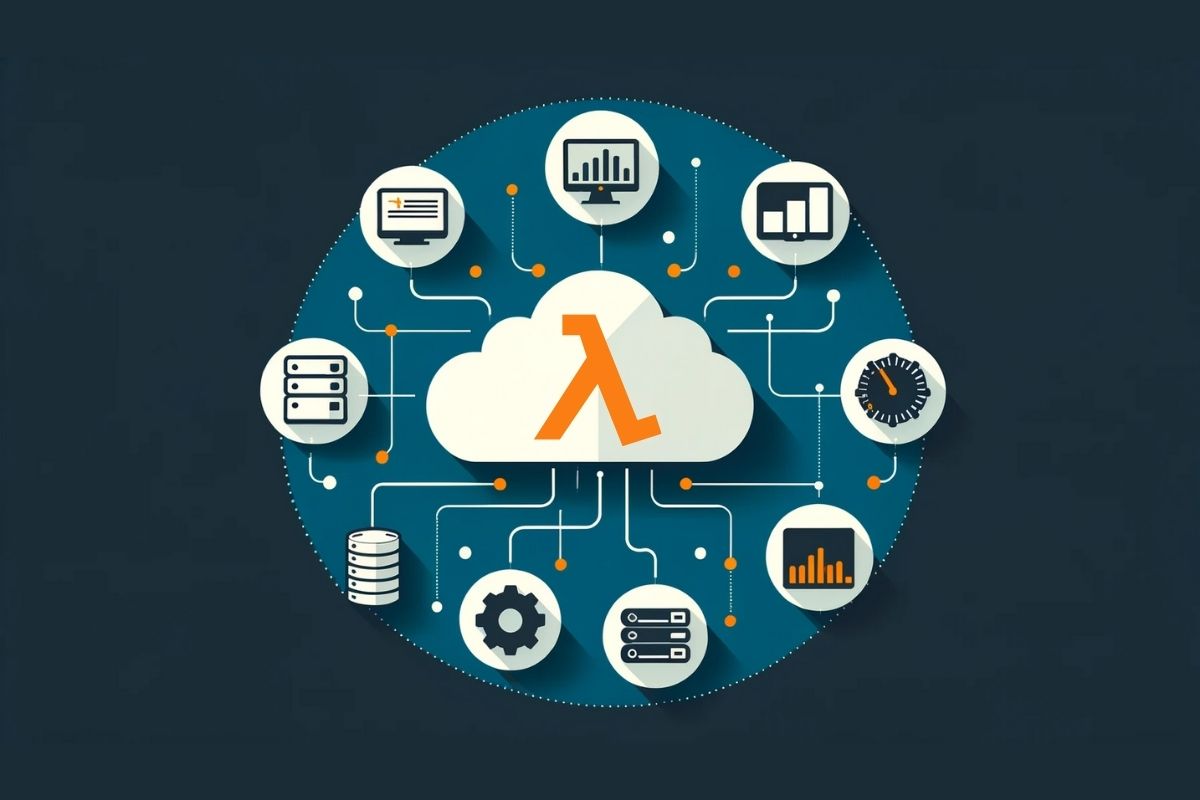
Introduction
In the realm of application development and deployment, AWS Lambda stands as a transformative force, challenging and reshaping traditional methodologies. This serverless computing platform offers developers the ability to focus solely on refining their code, while AWS Lambda takes care of the underlying infrastructure. With its event-driven and scalable nature, AWS Lambda provides efficiency and flexibility in application deployment and execution. In this article, we will explore the architectural nuances of AWS Lambda and delve into its various use cases.
AWS Lambda: A Paradigm Shift to Serverless Computing
At its core, AWS Lambda introduces a paradigm shift to serverless computing. This approach eliminates the need for developers to manage server infrastructure, allowing them to concentrate solely on their code and dependencies. AWS handles all aspects of server management, providing a serverless environment for developers to operate in. This serverless model offers numerous benefits, including cost reduction, faster development cycles, easier operational management, and scaling based on demand.
Refining the Architectural Details of AWS Lambda
Peeling back the layers of AWS Lambda reveals some intricate architectural details that contribute to its effectiveness. Let’s take a closer look at these nuances:
Serverless Model
AWS Lambda operates on a serverless basis, relieving developers of the burdens of server management. All server infrastructure is managed by AWS, freeing developers to focus on their code and application logic. This serverless model allows for more efficient resource allocation and eliminates the need for over-provisioning.
Event-driven Execution
Functions within AWS Lambda are triggered by specific events, such as changes in an Amazon S3 bucket or updates in a DynamoDB table. This event-driven execution enables a highly responsive system, where functions are executed as a direct response to events. This approach eliminates the need for polling services or custom event listeners.
Stateless Design
Each function in AWS Lambda is designed to be stateless, meaning it does not retain any state between executions. This necessitates the use of external storage solutions like DynamoDB or Amazon S3 for state persistence. By adopting a stateless design, AWS Lambda ensures scalability and fault tolerance.
Built-in Fault Tolerance
AWS Lambda is equipped with built-in fault tolerance capabilities. It ensures consistent computing capacity and infrastructure reliability, complemented by Amazon CloudWatch for monitoring and logging. In the event of failures or errors, AWS Lambda automatically retries function executions, ensuring reliability and resilience.
Concurrency and Scaling
AWS Lambda automatically scales its compute capacity based on the number of events. Whether triggered by an uploaded image, a new log file, or a database update, AWS Lambda adjusts its capacity accordingly. This scalability ensures that applications can handle varying workloads and maintain performance under high demand.
Short-lived Execution
Lambda functions within AWS Lambda are limited to a maximum execution time of 15 minutes. This constraint encourages developers to break down longer tasks into smaller segments, promoting efficient and modular code design.
Execution Role
To interact with other AWS services, Lambda functions use IAM roles. These roles are assumed by Lambda during function invocation, granting the necessary permissions to access and interact with other AWS resources. This ensures secure and controlled access to resources within the AWS ecosystem.
Integrated Security Model
AWS Lambda incorporates a comprehensive security model, integrating with AWS IAM, VPC, KMS, and CloudTrail. This integration enables robust security features, including granular access control, encryption at rest and in transit, and auditing and logging capabilities. By leveraging these security features, developers can build secure and compliant applications with ease.
Environment Variables
AWS Lambda allows developers to set environment variables for their functions. These variables can store configurations and secrets, eliminating the need to hardcode them into the code. This flexibility enhances code maintainability and security, as sensitive information can be securely stored and accessed through environment variables.
Cold and Warm Starts
The first invocation of a Lambda function is known as a “cold start.” During a cold start, the environment for the function is set up from scratch. Subsequent invocations of the function are known as “warm starts,” where the existing environment is reused for faster execution. Understanding the differences between cold and warm starts is crucial for optimizing the performance of Lambda functions.
VPC Support and Custom Runtimes
AWS Lambda supports access to resources within a Virtual Private Cloud (VPC). This allows Lambda functions to securely access resources within a private network, enhancing security and isolation. Additionally, AWS Lambda supports the use of custom runtimes, enabling developers to use programming languages and frameworks beyond the native options provided by AWS.
Layers
AWS Lambda provides the concept of “layers,” which allows developers to manage code and dependencies across multiple functions. With layers, developers can package common code, libraries, or even custom runtimes and share them across multiple functions. This promotes code reusability, reduces duplication, and simplifies the management of dependencies.
AWS Lambda Use Cases
AWS Lambda offers a wide range of use cases, leveraging its event-driven and scalable nature. Let’s explore some notable use cases where AWS Lambda shines:
Event-driven Data Processing
One of the most significant use cases for AWS Lambda is event-driven data processing. By seamlessly integrating with AWS services like DynamoDB and Kinesis, Lambda can be triggered to handle changes in a database or new data streams. This eliminates the need for polling services or custom event listeners, enabling real-time data processing and analysis.
Real-time File Processing
AWS Lambda can be integrated with Amazon S3 to enable real-time file processing. By utilizing S3 event notifications, Lambda functions can be triggered immediately upon file uploads to S3 buckets. This allows for immediate processing of files, such as image resizing, content transformation, or data extraction.
Serverless Backend for Web and Mobile Applications
AWS Lambda, in conjunction with AWS API Gateway, serves as a powerful serverless backend for web and mobile applications. This combination enables developers to build RESTful services without the need to manage physical servers. With Lambda functions handling the application logic and API Gateway providing HTTP endpoints, developers can focus on delivering efficient and scalable applications.
Automated Workflows with AWS Step Functions
AWS Step Functions, combined with AWS Lambda, allows for the automation of tasks and workflows. Step Functions provide a visual interface for orchestrating multiple Lambda functions, enabling sequential and parallel execution of tasks. This capability is particularly useful for building complex workflows, such as order processing, data pipelines, or business process automation.
Chatbots and Virtual Assistants
Lambda functions can be integrated with Amazon Lex to build dynamic and responsive chatbots and virtual assistants. By leveraging Lambda’s real-time processing capabilities, chatbots can engage with users, understand natural language inputs, and provide real-time responses. This enhances the user experience and enables the automation of customer service interactions.
IoT Backend Processing
AWS Lambda can be combined with AWS IoT Core to build scalable and efficient backends for IoT applications. By ingesting and processing data from various IoT devices in real-time, Lambda functions enable real-time decision-making and response. This use case showcases Lambda’s versatility in handling diverse data sources and providing real-time processing capabilities.
Integration with Third-Party Services
With its support for various SDKs, AWS Lambda can make API calls to third-party services, offering custom integrations beyond the AWS ecosystem. This flexibility enables developers to leverage existing services and expand the functionality of their applications. Whether integrating with payment gateways, social media platforms, or external data sources, Lambda provides the necessary capabilities for seamless integration.
Security and Compliance Automation
AWS Lambda, in combination with AWS Config, can automate security and compliance tasks. By responding to violations and anomalies detected by AWS Config, Lambda functions can automatically remediate issues and enforce security policies. This includes actions such as resetting permissions for inadvertently public S3 buckets, ensuring compliance with security standards, and automating disaster recovery and backup processes.
Image and Video Analysis
Lambda functions can be combined with Amazon Rekognition to automate image and video analysis tasks. This includes tasks such as face recognition, object detection, scene understanding, and content screening. By leveraging Lambda’s scalability and real-time processing capabilities, developers can efficiently analyze and extract insights from visual content.
Machine Learning Predictions
AWS Lambda can invoke models deployed on Amazon SageMaker, allowing for real-time predictions powered by scalable infrastructure. This enables developers to build applications that leverage machine learning models for tasks such as image classification, sentiment analysis, fraud detection, and recommendation systems. By combining Lambda with SageMaker, developers can achieve real-time predictions without the need for managing infrastructure.
These use cases demonstrate the versatility and power of AWS Lambda in enabling serverless application development. From event-driven data processing to real-time file processing, Lambda serves as a valuable tool for building scalable, efficient, and cost-effective applications.
Reasons to Use AWS Lambda
The benefits of using AWS Lambda are numerous and contribute to its widespread adoption. Here are some key reasons why businesses choose to leverage AWS Lambda in their application development:
Cost-Efficient Scaling
AWS Lambda’s pay-as-you-go model allows businesses to scale their applications efficiently while optimizing costs. With Lambda, businesses only pay for the actual compute time used by their functions, eliminating the need for over-provisioning and minimizing wasted resources. This cost-efficiency is particularly advantageous for applications with fluctuating workloads or unpredictable demand.
Effortless Infrastructure Management
Managing servers in traditional setups can be time-consuming and prone to errors. AWS Lambda eliminates the need for server management by handling all aspects of infrastructure provisioning, scaling, and maintenance. This allows developers to focus solely on writing code and refining their applications, leading to faster development cycles and improved productivity.
Flexibility and Versatility
AWS Lambda offers flexibility and versatility in application development. Its event-driven model allows applications to respond to specific events, enabling real-time processing and analysis. Lambda can be used for a wide range of applications, from building web APIs to processing real-time data streams and integrating with IoT devices. This flexibility makes Lambda a valuable tool for developers working on diverse projects.
Smooth Integration with AWS Services
AWS Lambda seamlessly integrates with various AWS services, simplifying complex workflows and enhancing application capabilities. Whether it’s integrating with Amazon S3 for file processing, DynamoDB for data storage, or API Gateway for building RESTful APIs, Lambda provides seamless integration and enables developers to leverage the full potential of the AWS ecosystem.
Enhanced Security Features
Lambda operates within Amazon’s Virtual Private Cloud (VPC), providing an isolated and secure environment for running functions. It integrates with AWS Identity and Access Management (IAM), allowing developers to define granular access control policies for their functions. Lambda also supports encryption at rest and in transit, ensuring the security and integrity of data processed by functions.
Rapid Deployment and Iteration
AWS Lambda’s efficient deployment model enables developers to deploy and iterate their applications quickly. With Lambda, developers can update code and configurations without disrupting the entire application, leading to faster development cycles and improved time-to-market. This agility is crucial in the fast-paced world of software development.
Consistent Environment
AWS Lambda ensures consistency across different environments, including production, testing, and development. This consistency minimizes unexpected deployment issues and allows developers to focus on writing code rather than managing environment-specific configurations. A consistent environment leads to predictable outcomes and smoother operations.
In conclusion, AWS Lambda represents a significant advancement in cloud computing, offering cost-efficiency, scalability, and ease of management. Its serverless, event-driven architecture simplifies application development and deployment, allowing developers to focus on writing code and refining their applications. With its wide range of use cases and benefits, AWS Lambda is a valuable tool for modern application development. Embracing AWS Lambda enables businesses to build scalable, efficient, and cost-effective applications in the ever-evolving cloud computing landscape.





